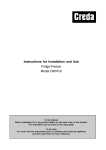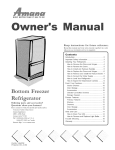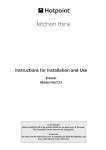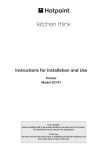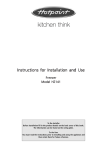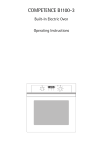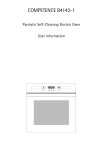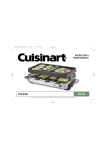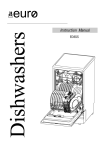Download Instructions for Installation and Use Freezer Model CUZ12G
Transcript
Instructions for Installation and Use Freezer Model CUZ12G To the Installer Before installation fill in the product details on the back cover of this booklet. The information can be found on the rating plate. To the User You must read the instructions prior to installing and using the appliance and then retain them for future reference. CONTENTS Product Safety Installation Electrical Connection Get to Know your Appliance Getting your Appliance ready for use How to use your Freezer Food Storage Energy Saving Tips Caring for your Appliance Troubleshooting Key Contacts 3 3 4 5 6 6 7-8 9 10 11 Back Cover Retention of this Instruction Book This Instruction Book must be kept handy for reference as it contains important details on the safe and proper use of the appliance. If you sell or pass the appliance to someone else, or move house and leave it behind, make sure this Book is also provided so the new owner can become familiar with the appliance and safety warnings. If the Book is lost or damaged a copy may be obtained from: GDA LTD., Morley Way, Peterborough, PE2 9JB GB 2 PRODUCT SAFETY 8. Never clean the appliance or perform maintenance without first turning off the green light and disconnecting it from the electrical mains. 9. Before having your old refrigerator picked up for disposal, remove or make inoperable any locking devices to prevent children who might play in or around the appliance from being locked inside. 10. Before calling for service/assistance in the case of malfunction, consult the chapter entitled “Troubleshooting" to determine whether it is possible to eliminate the problem. Do not try to repair the problem by trying to access the internal components of the appliance. 11. If damaged, the power supply cord on this appliance must necessarily be replaced by our service centre because special tools are required for replacement. 12. Do not use electric appliances inside the compartment for food storage, if these are not those recommended by the manufacturer. 13. At the end of the functional life of your appliance – containing cyclopentane gas in the insulation foam and perhaps gas R600a (isobutane) in the refrigeration circuit – the latter should made safe before being sent to the dump. For this operation, please contact your dealer or the Local Organisation in charge of waste disposal. ATTENTION Read your manual carefully since it contains instructions which will ensure safe installation, use and maintenance of your appliance. Your Refrigerator is built to International safety standards (EN60) and has been awarded the European approval mark (IMQ) for compliance with UK electrical safety requirements. It also meets the EC standards on the prevention and elimination of radio interference (EC directive 87/308 - 02.06.89). 1. This appliance must not be installed outdoors - not even in an area protected by a roof. It is extremely dangerous to leave it exposed to rain or storms. 2. It must only be used by adults and exclusively to refrigerate and freeze foodstuffs, following the instructions for use contained in this manual. 3. Do not ever touch or handle the appliance with bare feet or with wet hands or feet. 4. It is highly recommended that you do not use extension cords or multiple socket adapters. If the refrigerator is installed between cabinets, make sure that the cord is not bent or dangerously pinched or compressed. 5. Never pull on the cord or the refrigerator to remove the plug from the wall socket - this is very dangerous. 6. Never touch the cooling components within the appliance, especially with wet hands because this could result in injury. 7. Never put ice cubes just removed from the freezer into your mouth because they could stick to your mouth and cause burns. INSTALLATION To ensure that the appliance operates properly and to reduce energy consumption, it is important that the appliance is installed correctly. Electrical Connection and Earthing Before proceeding with the electrical connection, make sure that the voltage indicated on the rating plate, located within the freezer, corresponds to the mains voltage in your home and that the socket is fitted with a standard earthing wire in accordance with safety standards for 46/90 systems. If the socket is not fitted with an earthing wire, the manufacturer will not be held liable for any damages and/or injuries arising out of the use of the appliance. Do not use multiple sockets or adapters. Position the appliance in such a way that you can access the socket where it is plugged in. Ventilation The compressor and condenser generate heat and, therefore, need to be ventilated properly. Avoid placing the appliance in direct sunlight, or next to an electric stove or similar appliance. Areas not adequately ventilated are not suitable for this appliance. During installation, make sure not to cover or obstruct the grates that allow for proper ventilation of the appliance. Insufficient power? The electrical socket must be able to handle the maximum power load of the appliance, which is indicated on the rating plate located within the freezer. Away from Heat Avoid positioning the appliance in a place where it is directly exposed to sunlight or near an oven, hob or the like. Before making the electrical connection ... Level After the appliance has been delivered, place it in the vertical upright position and wait at least 3 hours before inserting the plug into the socket in order to ensure that it functions properly. The appliance must be level. Use the adjustable front feet to level the appliance. 3 GB ELECTRICAL CONNECTION Fitting a new plug Your appliance is supplied with a 13amp fused plug that can be plugged into a 13amp socket for immediate use. Before using the appliance please read the instructions below. IMPORTANT: WIRES IN THE MAINS LEAD ARE COLOURED IN ACCORDANCE WITH THE FOLLOWING CODE... Green and Yellow Earth Blue Neutral Brown Live WARNING: THIS APPLIANCE MUST BE EARTHED. Replacing fuse covers: When replacing a faulty fuse, a 13amp ASTA approved fuse to BS 1362 should always be used and the fuse cover re-fitted. If the fuse cover is lost, the plug must not be used until a replacement is obtained. As the colours of the wires in the mains lead may not correspond with the coloured markings identifying the terminals in your plug, proceed as follows: Connect Green and Yellow wire to terminal marked 'E' or or coloured green or Green and Yellow. Connect Brown wire to terminal marked 'L' or coloured red or brown. Connect Blue wire to terminal marked 'N' or coloured Black or Blue. Replacement fuse covers: If a replacement fuse cover is fitted, it must be of the correct colour as indicated by the coloured marking or the colour that is embossed in words on the base of the plug. If a 13amp plug (BS 1363) is used it must be fitted with a 13amp fuse. A 15amp plug must be protected by a 15amp fuse, either in the plug or adaptor or at the distribution board. Changing the plug: Removing the plug If your appliance has a non-rewireable moulded plug and you should wish to remove it to add a longer cable or to re-route the mains cable through partitions, units etc. please ensure that either: The plug is replaced by a fused 13amp rewireable plug bearing the BSI mark of approval. or The mains cable is wired directly into a 13amp cable outlet, controlled by a switch (in compliance with BS 5733) which is accessible without moving the appliance. If you are in any doubt about the electrical supply to your machine, consult a qualified electrician before use. CE Marking certifies that this appliance conforms to the following EEC directives : Low Voltage Equipment - 73/23/EEC & 93/68 EEC Electromagnetic Compatibility 89/336/EEC, 92/31/EEC & 93/68/EEC Disposing of the plug Cut off and dispose of the supplied plug if it does not fit your socket. The cable should be cut as close as possible to the moulded plug. Remove the fuse. WARNING: To avoid a shock hazard do not insert the discarded plug into a socket anywhere else. GB 4 GET TO KNOW YOUR APPLIANCE D Temperature Control This regulates the temperature inside the appliance automatically. Turn the knob from setting 1 to 5 for increasingly colder temperatures. To adjust the temperature control, use a coin to turn the knob. Ice tray compartment Compartment for freezing and storage Storage compartments Green Light When the light is on (by moving the switch to the right) this indicates that the appliance is connected to the mains. When the switch is moved to the left (green light covered), the appliance is disconnected from the mains. Defrost water drain system Yellow Light When this light is on (by moving the switch to the left), the compressor will operate continuously to reach the lower temperatures necessary for freezing fresh foods quickly. By moving the switch to the right (yellow light covered) the freezer is operated by the thermostat. D Red Light This light comes on when the temperature inside the appliance is not sufficient to preserve foodstuffs. 2 3 4 1 5 S N 0 I D A C B E F G H 5 GB GETTING YOUR APPLIANCE READY FOR USE ATTENTION: After the appliance has been delivered, leave it to stand in its upright position for approximately 3 hours, before plugging it into the mains and switching on, to ensure proper performance. Use these average temperature settings to ensure optimum performance and save energy. Before placing food in the freezer, clean the interior well with warm water and baking soda. After plugging the appliance into the socket, make sure that the green light is on - turn on the yellow light. When the red light goes off - turn off the yellow light. The appliance is now ready for use. Fill the ice trays and put in compartment 'E'. How to use your freezer Freezing Food Preservation - For the preparation of food to be frozen, please consult a specialized manual. - To preserve frozen and deep frozen food well, never set the temperature control below 1, no matter what the room temperature is. For room temperatures from 25°C to 27°C the temperature control should be set between 1 and 3. For room temperatures of up to 32°C set the control between 4 and 5. - In order to freeze fresh food, turn the switch to the left - to turn on the yellow light. - When freezing fresh foods, remember that they should not touch other previously frozen or deep frozen foods. Place the fresh food, that you wish to freeze, in the top compartment where the temperature will fall below 18°C, ideal for freezing food properly. - Proper conservation depends on the speed with which food is frozen. For this reason we recommend that the switch be turned on to the freeze setting (the yellow light will come on) 24 hours before the food to be frozen is placed in the freezer. This operation is necessary for large quantities of food (up to the maximum capacity, as indicated on the rating plate). - During the freezing process, avoid opening the door. - If a large amount of food is introduced for freezing at one time, the internal freezer temperature may momentarily increase and the red light will come on. When the compartment returns to the correct temperature, the red light will go out, preservation of foods stored is not affected. - IMPORTANT: Remember to turn off the yellow light after 24 hours as freezing will be completed. This will save energy. - Food that has thawed, even partially, must not be re-frozen: you must cook it in order to consume it (within 24 hours) or to freeze it once again. - In order to freeze and then thaw foods optimally, it is recommended that you divide food into small portions so that they freeze quickly and uniformly. The packages should be clearly marked with the content and the date they were frozen. - Do not open the door in the event of a power failure or malfunction. This precaution will slow the rise in temperature within the compartment. If the door is not opened, frozen and fastfrozen foods will remain in their current state for approximately 9-14 hours. - Do not place full bottles in the freezer: they could easily burst because all liquids increase in volume when they freeze. - Fill the ice cube trays about 3/4 full. GB 6 Maximum storage times for frozen foods are indicated in the tables, see 'FOOD STORAGE'. - Always follow the instructions on the packages of deep frozen foods carefully - if there are no instructions, never keep the food for more than 3 months from the date of purchase. - When buying deep frozen foods, ensure that they have been stored at appropriate temperatures and that the packaging is intact. If a package shows signs of moisture or abnormal swelling, it has probably been stored at the wrong temperature and the contents have been spoiled. - To maintain the quality of the deep frozen food, transport them in appropriate containers to keep them cold and then place them inside the freezer as soon as possible. FOOD STORAGE Meat and Fish Fo o d Wra pping Te nde ris ing (da ys ) S to ra ge (mo nths ) Tha wing time Be e f ro as ts Tin fo il 2/3 9 / 10 no t re quire d Lamb Tin fo il 1/2 6 no t re quire d Po rk ro as ts Tin fo il 1 6 no t re quire d V e al ro as ts Tin fo il 1 8 no t re quire d V e al / Po rk cho ps Each pie ce wrappe d in cling film and the n in tin fo il ( 4 to 6 s lice s ) 6 no t re quire d V e al / Lamb cutle ts Each pie ce wrappe d in cling film and the n in tin fo il ( 4 to 6 s lice s ) 6 no t re quire d Mince d Me at In aluminium co ntaine rs co v e re d with cling film 2 s lo wly in re frige rato r Plas tic bags 3 No t re quire d Cling film o r tin fo il 2 As ne ce s s ary He art and Liv e r S aus age s Fre s hly mince d Chicke n and Turke y Tin fo il 1/3 9 V e ry s lo wly in re frige rato r Duck and Go o s e Tin fo il 1/4 6 V e ry s lo wly in re frige rato r Phe as ant, Partridge and W ild Duck Tin fo il 1/3 9 V e ry s lo wly in re frige rato r Hare ans Rabbit Tin fo il 3/4 6 V e ry s lo wly in re frige rato r V e nis o n Tin fo il o r Cling film 5/6 9 V e ry s lo wly in re frige rato r Large Fis h Tin fo il o r Cling film 4/6 V e ry s lo wly in re frige rato r Small Fis h Plas tic bags 2/3 No t re quire d Crus tace ans Plas tic bags 3/6 No t re quire d She ll Fis h Sto re in s alt wate r in aluminium co ntaine rs o r plas tic co ntaine rs 3 V e ry s lo wly in re frige rato r Bo ile d Fis h Tin fo il o r Cling film 12 In ho t wate r Frie d Fis h Plas tic bags 4/6 Dire ctly in pan 7 GB FOOD STORAGE Fruits and Vegetables Fo o d Pre pa ra tio n Bla nc hing time Wra pping S to ra ge (mo nths ) Tha w ing time Pe e l and cut int o s lice s 2’ In co nt aine rs ( co v e r wit h s y up) 12 In re frige rat o r v e ry s lo wly Pe e l and pit 1’ / 2’ In co nt aine rs ( co v e r wit h s y rup) 12 In re frige rat o r v e ry s lo wly Rins e and dry In co nt aine r ( co v e r wit h s ugar) 10 / 12 In re frige rat o r v e ry s lo wly Co o ke d Fruit Cut , co o k and s t rain In co nt aine rs ( add 10% s ugar) 12 In re frige rat o r v e ry s lo wly Fruit juice W as h, cut and crus h In co nt aine rs ( s ugar t o t as t e ) 10 / 12 In re frige rat o r v e ry s lo wly Apple s and Pe ars Aprico t s , Pe ache s , Che rrie s and Plums St rawbe rrie s , Blacjbe rrie s and Ras pbe rrie s Cauliflo we r Re mo v e le av e s , cut he ad int o s mall pie ce s and blanch in wat e r and a lit t le le mo n juice 2’ Plas t ic bags 12 No t re quire d W as h and cut int o s mall pie ce s 1’ / 2’ Plas t ic bags 10 / 12 At ro o m t e mpe rat ure She ll and was h 2’ Plas t ic bags 12 No t re quire d W as h and s lice if re quire d 2’ Plas t ic bags 10 / 12 No t re quire d Carro t s , Pe ppe rs and Turnips Pe e l, was h and s lice if ne ce s s ary 3’ / 4’ Plas t ic bags 12 No t re quire d Mus hro o ms and As paragus W a s h , p e e l a n d cu t u p 3’ / 4’ Plas t ic bags o r co nt aine rs 6 At ro o m t e mpe rat ure W as h and mince 2’ Plas t ic bags 12 At ro o m t e mpe rat ure W as h and cut up int o s mall pie ce s 3’ Plas t ic bags o r co nt aine rs 6/7 No t re quire d Pre pa ra tio n Bla nc hing time Wra pping S to ra ge (mo nths ) Tha w ing time Bre ad Plas t ic bags 4 At ro o m t e mpe rat ure and in t he o v e n C a ke s Plas t ic bags 6 A bo ut 10 minut e s at ro o m t e mpe rat ure , co o k a t 100/200 C Cre am Plas t ic co nt aine rs 6 At ro o m t e mpe rat ure o r in re frige rat o r B ut t e r In o riginal wrapping o r t in fo il 6 In re frige rat o r Bo ile d Fo o d o r V e ge t able So up Plas t ic o r glas s co nt aine rs 3/6 At ro o m t e mpe rat ure o r in ho t wat e r Eggs Fre e z e wit ho ut s he lls in s mall co nt aine rs 10 At ro o m t e mpe rat ure o r in re frige rat o r Cabbage and Brus s e l Spro ut s Pe as Fre nch Be ans Spinach V e ge t able fo r So ups Va rio us Fo o ds GB 8 ENERGY SAVING TIPS - Close the Doors Open your freezer only when necessary, remember that every time you open the door, most of the cold air will be lost. To bring the temperature back to the proper level again, the motor must run for a considerable amount of time, consuming a substantial amount of energy. - Install the Appliance Properly In other words, away from sources of heat and direct sunlight, in a well ventilated room. - Correct Temperature Settings Set the temperature control to one of the middle settings. Very cold temperature settings will not only consume a great deal of energy but will neither improve nor lengthen the storage life of the food. - Check the Door Seal Keep the seal clean and make sure that they adhere well to the door. This alone will ensure that no cold air escapes. - Do not Overfill your Appliance Remember that proper storage of food requires good air circulation. Overfilling your appliance will hamper proper air circulation and overwork the compressor. - No Hot Foods A container of hot food placed in the freezer will increase the temperature significantly. Allow food to cool before storing. - Check your Appliance for build up of ice Check the interior walls for ice. Defrost your appliance when the layer becomes too thick (see section, 'CARING for your APPLIANCE'). 9 GB CARING FOR YOUR APPLIANCE Before doing any cleaning, turn off the green light and disconnect the appliance from the electricity (by pulling out the plug or turning off the general switch in your home). Cleaning and Special Maintenance Defrosting - Use a water and bicarbonate solution to clean the appliance. Clean the interior and exterior with a sponge soaked in warm water and a sodium bicarbonate solution, which is, among other things, a good disinfectant. If you do not have any in the house, you can use a neutral soap. - DO NOT use abrasive detergents, bleach or deterents containing ammonia. NEVER use solvent based products. - Rinse with clean water and dry with care. - When completed, turn on the green light and set the temperature control to the appropriate setting. - After 2-3 hours, the appliance will once again be ready for preserving frozen and deep frozen foods. WARNING: do not damage the refrigeration circuit. Do not use mechanical devices or instruments other than those recommended by the manufacturer to speed up the defrosting process. How to Defrost the Freezer The frost should be removed from the walls of the appliance periodically. When defrosting, remove the frozen food from the appliance, wrap it in newspaper and store in a cool place. Since the rise in temperature will shorten the storage life of the food, it should be used as soon as possible. Never use sharp metal objects to remove frost because they could pierce the cooling circuit and damage the freezer beyong repair. Use the plastic scraper provided for this purpose. To defrost the appliance completely (this should be done once or twice a year), turn off the green light and leave the door open until the frost has completely thawed. A defrost water collection system is situated at the bottom of this appliance as shown in figure 1. - You can speed this process by placing containers of warm water in the appliance. Fig. 1 GB 10 Before cleaning the freezer, turn off the green light, switch off and remove the plug from the socket. TROUBLESHOOTING Green Light is off. Check that: · The mains switch in your home is on. · There has not been a power cut. · The plug is properly inserted in the socket and is switched on. · The socket is working; try another appliance in the socket to check. · The fuse in the plug is ok - if not replace it, (see ELECTRICAL CONNECTION). The Red Light is always on. Check that: · The door is shut properly. · The seal is clean and not damaged. · The door has not been left open too long. · The temperature control is on the correct setting. · The freezer is not overfilled. · There is not too much frost on the internal walls. If after all the checks, the appliance still does not operate or the problem perstists, call Creda Service, see KEY CONTACTS, back cover. Inform them of: - the type of problem - the abbreviation of the model name (Mod.) and the relative numbers (S/N) Information can be found on the rating plate, located within the freezer. More Troubleshooting information and general product advice can be found on our website at: www.theservicecentre.co.uk Never call on unauthorized technicians and always refuse spare parts which are not originals. The compressor runs continuously. Check that: · The door is shut properly or has not been left open too long. · The room temperature is not too high. · The temperature control is not set too high. · The yellow light is on (continuous operating function). The appliance makes too much noise. The refrigerant in the cooling circuit causes a slight bubbling sound, even when the compressor is not running (this is quite normal and is not a fault). Check that: · The appliance is level. · The appliance was installed between cabinets or objects that vibrate and make noise. Recycling & Disposal Information As part of Creda's continued commitment to helping the environment, we reserve the right to use quality recycled components to keep down customer costs and minimise material wastage. Please dispose of packaging and old appliances carefully. To minimise risk of injury to children, remove the door, plug and cut mains cable off flush with the appliance. Dispose of these parts separately to ensure that the appliance can no longer be plugged into a mains socket and the door cannot be locked shut. 11 GB 195.037.029.00 April 2003 Part no. FP194 - 01












